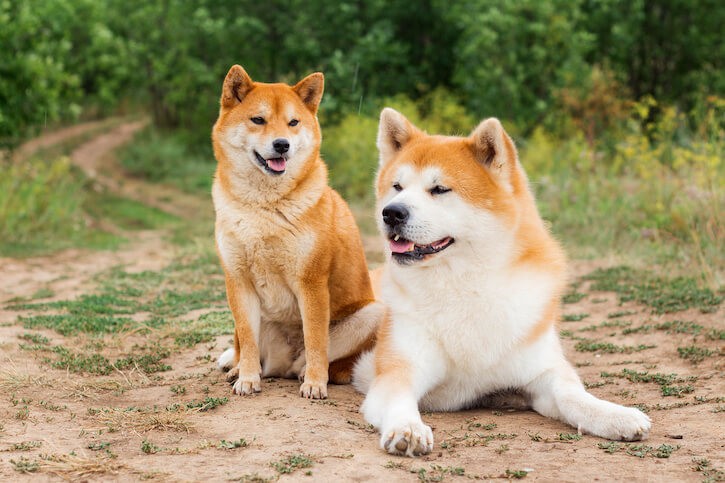
The Japanese Akita and Shiba Inu, both treasured native breeds of Japan, represent distinct ends of the size spectrum in Japanese dog breeds while sharing some notable physical traits like the characteristic curved tail and triangular ears. While the Akita stands as a large, powerful working dog weighing up to 130 pounds, the Shiba Inu is a compact companion at just 15-30 pounds. Despite their common ancestry dating back thousands of years and similar double-coated appearance, these breeds differ significantly in temperament, care requirements, and suitability for different living situations. This report examines their key distinguishing features to help prospective owners make informed decisions.
Japanese Akita vs Shiba Inu Comparison
Ancestral Hunting Roles
Both breeds have deep Japanese hunting roots, though they served different purposes. The Akita's history traces back to medieval Japan, where they evolved from hunting dogs to also become guard and fighting dogs after being crossed with breeds like the Tosa. Meanwhile, Shiba Inus, potentially dating back 9,000 years, were specifically bred as bird flushers and small game hunters, occasionally hunting wild boar in packs. Modern Shibas retain strong hunting instincts, particularly for birds and small backyard wildlife.
Training and Social Characteristics
Both breeds exhibit strong-willed personalities but differ in their social tendencies. Akitas generally perform better as single dogs due to potential aggression issues with other pets, while Shibas show better tolerance for multi-pet households. Early training is crucial for both breeds due to their independent nature, though Shibas are noted for being more adaptable to apartment living despite their high energy levels. Akitas require more space and careful socialization due to their protective instincts and larger size. While both breeds can be reserved with strangers, Akitas tend to be more overtly protective of their families, whereas Shibas typically display a more aloof demeanor.
Physical Differences Between Japanese Akita and Shiba Inu & Temperament Traits
Size and Appearance Distinctions
The most notable physical difference between these breeds lies in their size. Male Akitas stand 26-28 inches tall at the shoulder and can weigh up to 130 pounds, while male Shiba Inus measure just 14.5-16.5 inches and typically weigh around 23 pounds. The breeds also differ in coloring - while Shibas primarily come in red, black and tan, and sesame, American Akitas display a wider variety of color patterns. Their head structures also differ, with Akitas having a broader, more substantial head compared to the Shiba's more fox-like features.
Characteristic Behavioral Traits
While the previous sections covered general training and social aspects, this section focuses specifically on inherent temperament differences. The Akita exhibits a dignified and courageous nature, displaying strong protective instincts and profound loyalty to their family unit. They tend to be more serious and reserved in their demeanor. In contrast, Shiba Inus demonstrate what breed experts describe as "spirited boldness" combined with good nature. They exhibit more cat-like traits, including natural cleanliness that makes them easier to housetrain. Both breeds share remarkable intelligence but channel it differently - Akitas through protective vigilance and Shibas through clever, sometimes manipulative behavior with their owners. Their shared independence manifests uniquely: Akitas through protective aloofness and Shibas through playful detachment.
Health and Care Requirements
Lifespan and Medical Considerations
While both breeds face some similar health challenges like hip dysplasia and thyroid issues, they have distinct life expectancies and care needs. Shiba Inus generally live longer, with a lifespan of 13-16 years compared to the Akita's 10-14 years. Shibas are particularly prone to knee problems and allergies, while Akitas must be monitored for bloat due to their large size. Both breeds require special attention to their digestive health, with Shibas being especially sensitive to certain proteins like chicken.
Grooming and Dietary Requirements
Both breeds have unique maintenance needs beyond the basic grooming covered in previous sections. Shibas experience two heavy shedding periods annually during fall and spring when they shed their undercoat, requiring increased grooming attention during these times. For optimal health, Akitas need a high-protein diet due to their active nature and large size, while Shibas benefit from high-fiber diets supplemented with probiotics to manage their sensitive digestion. Professional grooming is recommended every 2.5-3 months for both breeds, though their specific grooming protocols differ based on size and coat type. The cost of maintaining these breeds also varies significantly, with purebred Akita puppies typically ranging from $600-$2000, while Shiba Inus command higher prices of $1400-$3500 from reputable breeders.
Conclusion
The comparison between Japanese Akitas and Shiba Inus reveals two distinct breeds sharing Japanese hunting heritage but differing significantly in size, temperament, and care requirements. While Akitas are large, protective guardians weighing up to 130 pounds, Shiba Inus are smaller, more independent companions around 23 pounds. Both breeds exhibit strong-willed personalities and intelligence, though Akitas tend to be more overtly protective and better suited as single dogs, while Shibas show greater adaptability to multi-pet households and apartment living.
Key differences extend to health and maintenance needs, with Shibas generally living longer (13-16 years vs 10-14 for Akitas) but requiring careful attention to diet due to protein sensitivities. While both breeds need consistent training and grooming, potential owners should carefully consider their lifestyle, living space, and ability to meet each breed's distinct requirements - particularly the Akita's need for space and extensive socialization versus the Shiba's more adaptable but still independent nature. These findings suggest that proper breed selection should be based on matching these specific traits and care needs to the owner's circumstances and capabilities.